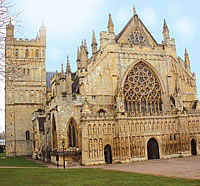|
Editor:
Marc Bridle
Webmaster: Len Mullenger
|
Seen and Heard Concert Review
The latest in The Sixteen's
Choral Pilgrimage 2006 concert series made a
truly grand finale to Exeter Summer Festival. Long acknowledged
for their expertise in interpreting Victoria, Harry
Christophers and his twenty-strong group brought an
evening of choral splendour to the magnificence of Exeter's
thirteenth century Cathedral. An extraordinary mix of
precision, poise and passion made this concert memorable.
Nearly fifty years on (and twenty five since Harry Christophers founded The Sixteen) musicology and performance standards have developed a good deal. It is no longer true that a limited number of groups perform Victoria's works and a quick search through Amazon produces a host of recordings from different parts of the world. The Sixteen however, features prominently in the best-seller list and so they should, because they are the new standard now, at least for me.
The Marian motets that surrounded the Requiem in this concert, illustrated all of the meaning that this music holds for Harry Christophers. Some are passionate pieces, especially those based on The Song of Songs. In Vadam et circuirbo civitatem for example, at the words 'Dilectus meus candidus et rubicundus' - 'My beloved is white and ruddy' the music though still reverential, has a decidedly erotic flavour, far more delicate than Strauss five centuries later of course, but nonetheless deeply expressive and meaningful. This quality, repeated in both Quam pulchri sunt gressus tui and in Nigra Sum sed formosa - 'I am a black but comely daughter of Jerusalem' conveyed the double standard of the imagery perfectly - applied as it was later in church history in praise of the Virgin.
The general seamlessness of vocal line and the poise of The Sixteen's phrasing was particularly noticeable in the Requiem. After the unison intonation of each first line, ('Requiem aeternam,' ' Kyrie Elison' 'Lux Aeterna' and so on) the entrance of further voices was so subtle as to be almost undetectable; the development of the polyphony grew organically, so to speak, from the intonation as a natural and perfect continuation every time. Controlled development such as this was in fact one of the hallmarks of this concert.
The other hallmark was the rock-like quality of the chordal singing and the unison plainchant passages. In each, no voice was anywhere else than in perfect alignment with the others; chords were vertical so to speak, completely balanced in dynamic and exactly in time throughout their whole compass. Precision like this comes only from expert singers guided by expert direction. Congratulations are due in every respect to Harry Christophers and his remarkable choir for this magisterial performance.
Bill Kenny
Back to the Top Back to the Index Page |
| ||
|
||||



